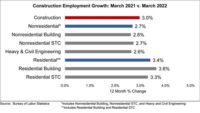"The pace of construction activity in January and February was unusually strong, aided by warm winter weather that helped to push forward the timing of construction starts," stated Robert A. Murray, vice president of economic affairs for McGraw-Hill Construction. "The March decline in effect 'compensates' for the heightened activity at the start of 2002, so perhaps a better reading of the construction industry comes from looking at the average for the year's first three months.
Total construction during the first quarter of 2002 proceeded at an annual rate of $501.0 billion, a 2% gain over both the previous quarter and the average for all of 2001. This is consistent with the sense that construction contracting is now leveling off, compared to last year's 4% gain, while still remaining at a reasonably healthy volume. At the same time, there would be mounting concern should the March rate of contracting be repeated in April and May," Murray said.
Nonresidential building in March slipped 10% to $150.6 billion. The commercial categories featured declines of 23% for stores and 20% for hotels, while office construction was unchanged from February and warehouses advanced 10%. Construction of manufacturing plants plunged a sharp 51% after the improved amount in February. Murray stated, "Despite signs that the nation's industrial sector is beginning to strengthen, the recovery for manufacturing plant construction is not likely to take hold in a sustained manner before next year."
The institutional side of the nonresidential market in March was mixed. School construction fell 11%, following its very strong contracting during the first two months of the year. Church construction was down 10%, while public buildings (courthouses and detention facilities) retreated 37%. On the plus side, both healthcare facilities and amusement-related projects registered 7% gains. The transportation terminal category jumped 71%, helped by the start of a $283 million reconstruction of the PATH train terminal in lower Manhattan (N.Y.), plus the start of a $77 million airline terminal expansion in Anchorage, AK.
During the first three months of 2002, total construction on an unadjusted basis was 1% below the same period in 2001. Pulling total construction downward was a 14% decline for nonresidential building compared to last year, outweighing gains of 9% for residential building and 3% for nonbuilding construction. On a regional basis, total construction in the January-to-March period was the following: the South Atlantic, up 12%; the Midwest, up 6%; the Northeast, up 4%; the West; down 9%; and the South Central, down 13%.



